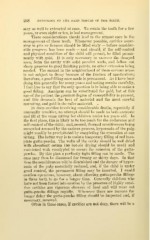Page 420 - My FlipBook
P. 420
268 PATHOLOGY OF THE HARD TISSUES OF THE TEETH.
may as well be extracted at once. To retain the tooth for a few
years, or even eight or ten, is bad management.
These considerations should lead to the utmost care in the
management of these teeth. Whenever possible, cavities occur-
ring in pits or fissures should be filled early — before consider-
able progress has been made — and should, if the self-control
and physical condition of the child will permit, be filled perma-
nently with gold. It is only necessary to uncover the decayed
area, form the cavity with solid parallel walls, and follow out
sharp grooves to good finishing points, no other extension being
needed. The enamel in the neighborhood of these carious areas
is not subject to decay because of the friction of mastication;
therefore, a good filling once made is permanent. As I have been
doing this generally for many years and noting results carefully,
I feel free to say that the only question is in being able to make a
good filling. Amalgam can be substituted for gold, but at this
age of the patient the greatest degree of susceptibility is present,
and this demands the best of material and the most careful
operating, and gold is the safer material.
In deep cavities involving considerable dentin, especially if
unusually sensitive, no attempt should be made to both excavate
and fill at the same sittiug for children under ten years old. In
the first place, this is likely to be too much for the endurance and
self-control of the child ; and, second, thermal sensitiveness being
somewhat aroused by the carious process, hyperemia of the pulp
might readily be precipitated by completing the operation at one
sitting. The better way is to make a temporary filling of red base-
plate gutta-percha. The walls of the cavity should be well dried
with absorbent cotton (no hot-air drying should be used) and
moistened with eucalyptol to secure the cohesion of the gutta-
percha. By this plan a perfectly tight filling can be made. The
case may then be dismissed for twenty or thirty days. In that
time the sensitiveness will be diminished and the danger of hyper-
emia of the pulp materially reduced, and, if the child is under
good control, the permanent filling may be inserted. I would
caution operators, however, about allowing gutta-percha fillings
in these teeth to go for a longer time. Generally children who
have not been forced into caution by the presence of highly sensi-
tive cavities are vigorous chewers of food and will wear out
gutta-percha fillings rapidly. Whenever there are reasons for
longer delay the gutta-percha filling should be inspected and, if
necessary, renewed.
Often in these cases, if cavities are not deep, there will be a


